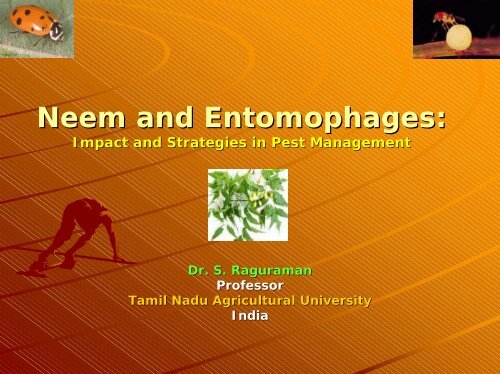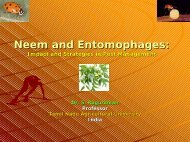Neem Vs Entomophagous Insects
Neem based pesticides and its safety to predators and parasitoids
Neem based pesticides and its safety to predators and parasitoids
You also want an ePaper? Increase the reach of your titles
YUMPU automatically turns print PDFs into web optimized ePapers that Google loves.
<strong>Neem</strong> and Entomophages:<br />
Impact and Strategies in Pest Management<br />
Dr. S. Raguraman<br />
Professor<br />
Tamil Nadu Agricultural University<br />
India
Is neem ‘a a good combiner’<br />
with entomophages in IPM?<br />
Yes !<br />
No ?<br />
Yes !!
Quotable Quotes<br />
“<strong>Neem</strong> products and parasitoids are perfect combiners in<br />
terms of IPM in rice” - Saxena (1989)<br />
“<strong>Neem</strong> seed kernel water extract is the best product of neem<br />
in containing the population of insect pests and in sparing<br />
the natural enemies” - Schmutterer (1990)<br />
“<strong>Neem</strong> seed extracts can be combined with natural enemies<br />
in the management of insect pests by understanding the<br />
biological effects on them” - Raguraman (1993)<br />
“Derivatives of neem are unlikely to cause substantial<br />
environmental damage and these products appear safer than<br />
synthetic neurotoxins” - Stark (2004)<br />
“<strong>Neem</strong> and bioagents are nature’s s twin gifts to mankind for<br />
their utility in the IPM” - Opender Koul (2004)<br />
“In the new millennium, ‘integrated biological control’<br />
includes natural enemies vis-à-vis other biopesticides<br />
synchronizing with ecological and behavioural aspects of<br />
insect pests” - Raguraman & Opender Koul (2004)
Entomophages<br />
Parasitoids<br />
• Egg parasitoids<br />
• Larval parasitoids<br />
• Pupal parasitoids<br />
Predators<br />
• <strong>Insects</strong><br />
• Spiders
Parasitoids<br />
Egg parasitoids<br />
• Telenomus remus<br />
• Trichogramma chilonis<br />
• Trichogramma pretiosum<br />
• Gryon fulviventre<br />
Larval Parasitoids<br />
• Diaraetiella rapae<br />
• Aphidius cerasicola<br />
• Bracon hebetor<br />
• Diadegma semiclausum<br />
• Cotesia glomerata<br />
Pupal parasitoid<br />
• Tetrastichus israeli
How to test the NEEM on<br />
Entomophages ?<br />
IOBC Method<br />
Laboratory<br />
• Toxicity<br />
Semi field<br />
Field<br />
• Toxicity<br />
• Recovery<br />
• Recovery<br />
But laboratory studies<br />
should include<br />
Oviposition deterrent effect<br />
Choice study<br />
No choice study<br />
Feeding deterrent Effect<br />
Toxicity<br />
Choice study<br />
No choice study<br />
Feeding<br />
Contact<br />
Sterility effects<br />
Single generation<br />
F2, F3..<br />
Growth inhibitory effects<br />
Pre-treatment<br />
Post-treatment<br />
treatment
<strong>Neem</strong> &<br />
Egg Parasitoids
<strong>Neem</strong> and Egg Parasitoids<br />
1.<br />
Telenomus<br />
remus<br />
Aqueous NSKE 2%<br />
Positive effect<br />
Joshi et al.<br />
(1982)<br />
2.<br />
Trichogramma<br />
pretiosum<br />
NSKE 2.5% & 3%<br />
Negative<br />
effect<br />
Klemm and<br />
Schmutterer<br />
(1993)<br />
3.<br />
T. pretiosum<br />
NSK based extract:<br />
NIM-20<br />
Positive effect<br />
Cano and<br />
Gladstone<br />
(1994)<br />
4.<br />
Trichogramma<br />
chilonis<br />
Aqueous, ethanolic and<br />
hexane extracts of NSK @<br />
0.3 to 5.0 %<br />
Both positive<br />
and Negative<br />
effects<br />
Raguraman<br />
(1993)<br />
5.<br />
T. chilonis<br />
<strong>Neem</strong>Azal-F F (1ml/lit),<br />
<strong>Neem</strong>Azal-T/S, NSKE 5%<br />
Positive effect<br />
Saikia and<br />
Parameshwaran<br />
(2001)<br />
6.<br />
T. chilonis<br />
Nimbecidine R 4 ml/l<br />
Positive effect<br />
Jalali and Singh<br />
(2003)<br />
7.<br />
T. chilonis<br />
NSKE 5%<br />
Positive effect<br />
Thirumurugan &<br />
Koodalingam<br />
(2005)<br />
8.<br />
Gryon<br />
fulviventre<br />
NSKE 5%<br />
Positive effect<br />
Mitchell et al.<br />
(2005)
Behavioural and<br />
Physiological Effects<br />
of <strong>Neem</strong> on<br />
Egg Parasitoid
Oviposition Deterrent Effect<br />
T. chilonis<br />
Choice Test
Oviposition Deterrent Effect<br />
T. chilonis<br />
No Choice Test
Feeding Deterrent Effect<br />
T. chilonis<br />
Choice Test
Feeding Deterrent Effect<br />
T. chilonis<br />
No Choice Test
Toxicity<br />
T. chilonis<br />
Feeding and Contact tests
Sterility & Growth Inhibitory Effects<br />
T. chilonis<br />
Via Feeding Via Contact
Growth Inhibitory Effects<br />
T. chilonis<br />
Post-treatment treatment of Eggs
<strong>Neem</strong> &<br />
Larval Parasitoids
<strong>Neem</strong> and Larval Parasitoids<br />
1.<br />
Diaraetiella<br />
rapae,<br />
Aphidius<br />
cerasicola<br />
NSKE 5%<br />
Positive effect<br />
Schauer(1985)<br />
2.<br />
Bracon<br />
hebetor<br />
<strong>Neem</strong> oil 5%<br />
Positive effect<br />
Jhansi and<br />
Sundarababu<br />
(1987)<br />
3.<br />
B. hebetor<br />
Aqueous, ethanolic and hexane<br />
extracts of NSK @ 0.3, 0.6, 1.2,<br />
2.5 & 5.0%<br />
Both positive<br />
and negative<br />
effects<br />
Raguraman<br />
(1993)<br />
4.<br />
B. hebetor<br />
Repelin and <strong>Neem</strong>guard<br />
Positive effect<br />
at lower<br />
concentration<br />
Srinivasa Babu<br />
et al. (1996)<br />
5.<br />
Diadegma<br />
semiclausum<br />
NSKE 0.1-5%<br />
Positive effect<br />
Schneider and<br />
Madel (1991)<br />
6.<br />
Cotesia<br />
glomerata<br />
Higher concentration (40 ppm)<br />
of azadirachtin and Aza. Free<br />
fraction and 50 and 100 ppm of<br />
enriched product<br />
Negative<br />
effect<br />
Schmutterer<br />
(1992)<br />
7.<br />
C. glomerata<br />
Agroneem (4.8 mg a.i./l)<br />
<strong>Neem</strong>ix (20 mg a.i/l)<br />
Ecozin (20 mg a.i/l)<br />
Positive effect<br />
Haseeb et al.<br />
(2005)
Behavioural and<br />
Physiological Effects<br />
of <strong>Neem</strong> on Larval<br />
Parasitoid
Oviposition Deterrent Effect<br />
B. hebetor<br />
Choice Test
Oviposition Deterrent Effect<br />
B. hebetor<br />
No Choice Test
Growth Inhibitory Effects<br />
B. hebetor<br />
Treatment of parasitoid grubs / host larvae
<strong>Neem</strong> &<br />
Predatory <strong>Insects</strong> and<br />
Spiders
Predatory <strong>Insects</strong><br />
<strong>Insects</strong><br />
• Earwig<br />
• Cricket<br />
Forficula auricularia<br />
Metioche vittaticollis<br />
• True bugs<br />
• Ants<br />
• Beetles<br />
• Syrphid<br />
Cyrtorhinus lividipennis<br />
Contarinia sorghicola<br />
Orius sp<br />
Ectatomma vuridum<br />
Coccinella undecimpunctata<br />
Chielomenes sexmaculata<br />
Brumoides suturalis<br />
Scymnus sp<br />
Cryptolaemus montrouzieri<br />
Hippodamia variegata<br />
Episyrphus balteatus<br />
• Lacewings<br />
Chrysopa scelestes<br />
Chrysoperla carnea
<strong>Neem</strong> and True bugs<br />
1.<br />
Cyrtorhinus<br />
lividipennis<br />
<strong>Neem</strong> oil 3%<br />
NSKE 5%<br />
Positive<br />
effect<br />
Fernandez<br />
et al (1992)<br />
2.<br />
Orius majusculus<br />
<strong>Neem</strong>azal-T/S<br />
(1:200, 1:100,<br />
1:50)<br />
Positive<br />
effect at<br />
lower<br />
dose<br />
Drescher and<br />
Madel (1995)<br />
3.<br />
Microvelia<br />
caliginosus<br />
<strong>Neem</strong>-Amin<br />
EC<br />
Stardoor<br />
B.P. 20/S<br />
Negative<br />
effect<br />
Tedeschi et al.<br />
(2001)
<strong>Neem</strong> and Predatory Beetles<br />
1.<br />
Coccinella<br />
undecimpunctata<br />
<strong>Neem</strong> oil 1%<br />
Positive effect<br />
Lowery and<br />
Isman<br />
(1995)<br />
3.<br />
Cryptolaemus<br />
montrouzieri<br />
NSKE 5%<br />
Positive effect<br />
Mani et al.<br />
(1997)<br />
2.<br />
Cheilomenes<br />
sexmaculata<br />
<strong>Neem</strong> oil 20 to<br />
200 ppm<br />
Positive effect<br />
Oi et al.<br />
(2001)<br />
4.<br />
C. sexmaculata<br />
NSKE 5%<br />
Positive effect<br />
Balikai and<br />
Lingappa<br />
(2004)<br />
5.<br />
Hippodamia variegata<br />
NSKE (25 g/l)<br />
<strong>Neem</strong>Azal-T/S 1%<br />
Positive effect<br />
Hamd et al.<br />
(2005)
<strong>Neem</strong> and Lacewings<br />
1.<br />
Chrysopa scelestes<br />
NSKE 2%<br />
Positive<br />
effect<br />
Joshi et al.<br />
(1982)<br />
2.<br />
Chrysoperla carnea<br />
AZT-VR<br />
VR-K<br />
with neem oil<br />
(250-30,000<br />
ppm)<br />
Positive<br />
effect<br />
Kaethner<br />
(1990, 1991)<br />
3..<br />
C. carnea<br />
NSKE 5%<br />
Econeem 2%<br />
Positive<br />
effect<br />
Ingawale et al.<br />
(2005)
Spiders<br />
Predatory Spiders<br />
• Cheiracanthium mildei<br />
• Lycosa pseudoannulata<br />
• Oxyopes javanus<br />
• Mastigoproctus giganteus
<strong>Neem</strong> and Predatory Spiders<br />
1.<br />
Cheiracanthium<br />
midei<br />
NSKE 2% and<br />
solvent extracts of<br />
neem @ 4%<br />
Positive<br />
effect<br />
Mansour et<br />
al. (1986,<br />
1987)<br />
2.<br />
Lycosa<br />
pseudoannulata<br />
NSKE 5%,<br />
<strong>Neem</strong> oil 3%,<br />
<strong>Neem</strong> Cake Extract 10%<br />
Positive<br />
effect<br />
Saxena et al.<br />
(1984)<br />
Raguraman<br />
(1987)<br />
Raguraman<br />
and<br />
Rajasekaran<br />
(1996)<br />
3.<br />
L. pseudoannulata<br />
Margosan-O R 1500<br />
ppm<br />
Positive<br />
effect<br />
Markandaya<br />
and<br />
Divakar<br />
(1999)<br />
4.<br />
L. pseudoannulata<br />
<strong>Neem</strong> oil 3%<br />
Biobit R<br />
Positive<br />
effect<br />
Rao et al.<br />
(2003)<br />
5.<br />
Mastigoproctus<br />
giganteus<br />
<strong>Neem</strong> seed extract<br />
1 to 10 mg/l<br />
Negative<br />
effect<br />
Punzo et al.<br />
(2005)
How to Conclude ?
Conclusions<br />
For egg parasitoids:<br />
– Egg parasitoids are susceptible, when they come in direct contact with neem<br />
products. The application of neem may adversely affect the beneficial<br />
capacity. So the inundative release of the egg parasitoid, T. chilonis is<br />
suggested 3-4 days before or after the neem product’s application.<br />
For larval parasitoids:<br />
– The external larval parasitoids are no exception to the ill effects, if they are<br />
in direct contact with neem products. To avoid this, for inundative releases,<br />
application of neem products may be followed by the release of the<br />
parasitoids and spraying may be avoided if the parasitoids are in larval<br />
stages in the field. Hence, pre-treatment sampling is suggested, be it internal<br />
or external, for timing the application of neem products.<br />
For predatory insects and spiders:<br />
– In some cases the predation efficiency may be reduced and growthdisrupting<br />
compounds of neem may affect the first line juvenile instars of<br />
insects and fecundity of treated adults in the laboratory. But, far less drastic<br />
or even no effects are observed under semi-field or field conditions. This is<br />
partly due to the fast breakdown of the active principles under field<br />
conditions. Hence, timing the application of neem is suggested.
Thank You



